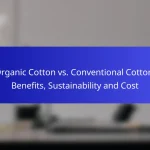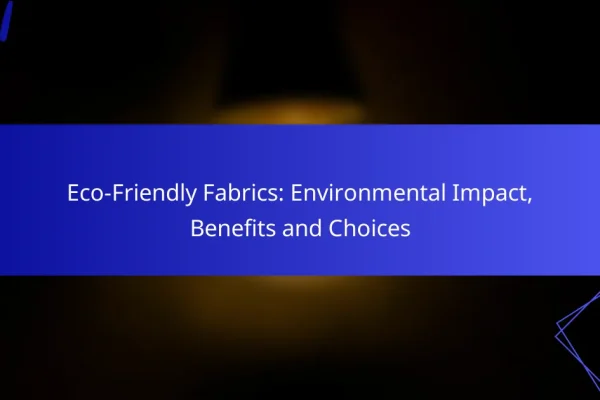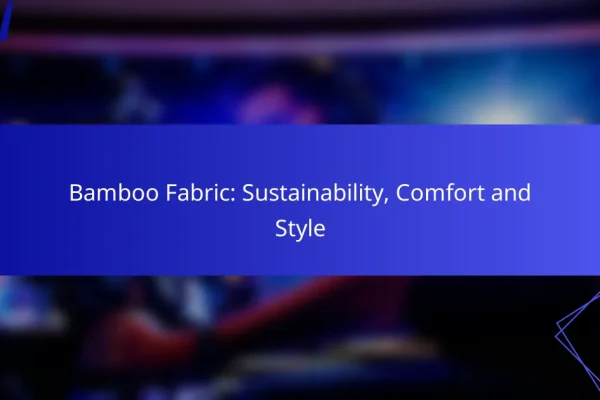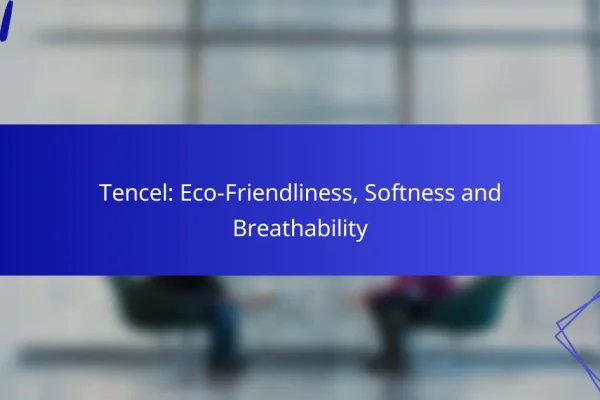What are the best sustainable clothing materials?
The best sustainable clothing materials include organic cotton, Tencel, hemp, recycled polyester, and bamboo fabric. These materials are chosen for their lower environmental impact and renewable sourcing, making them ideal for eco-conscious consumers.
Organic cotton
Organic cotton is grown without synthetic pesticides or fertilizers, which helps maintain soil health and reduces water pollution. This type of cotton typically uses less water than conventional cotton, making it a more sustainable choice.
When shopping for organic cotton clothing, look for certifications such as GOTS (Global Organic Textile Standard) to ensure the product meets strict environmental and social criteria.
Tencel
Tencel, made from sustainably sourced wood pulp, is known for its softness and breathability. The production process uses a closed-loop system that recycles water and solvents, minimizing waste and environmental impact.
Clothing made from Tencel is biodegradable and often blended with other fibers for enhanced durability. It is a great option for those seeking comfort and sustainability in their wardrobe.
Hemp
Hemp is a highly sustainable crop that requires minimal water and no pesticides. Its fibers are strong and durable, making hemp clothing long-lasting and resistant to wear.
Hemp fabric can be blended with other materials for added softness and versatility. Look for hemp clothing that is certified organic to ensure environmentally friendly practices were used in its production.
Recycled polyester
Recycled polyester is made from post-consumer plastic bottles and other plastic waste, diverting materials from landfills. This process significantly reduces the carbon footprint compared to producing virgin polyester.
When choosing recycled polyester clothing, check for certifications like the Global Recycled Standard (GRS) to ensure the product meets sustainability criteria. It is a practical choice for activewear and outerwear.
Bamboo fabric
Bamboo fabric is derived from the fast-growing bamboo plant, which requires little water and no pesticides. It is naturally antibacterial and moisture-wicking, making it suitable for various clothing types.
However, the production process can sometimes involve harsh chemicals, so look for brands that use eco-friendly methods. Certifications like Oeko-Tex can help identify safer bamboo products.
How do sustainable materials impact the environment?
Sustainable materials significantly reduce environmental harm by minimizing resource depletion and pollution. They promote eco-friendly practices that help preserve ecosystems and reduce the overall ecological footprint of the fashion industry.
Reduced carbon footprint
Sustainable clothing materials often have a lower carbon footprint compared to conventional fabrics. For instance, organic cotton and Tencel are produced with methods that emit fewer greenhouse gases, contributing to climate change mitigation.
Choosing materials with certifications like Global Organic Textile Standard (GOTS) can help consumers identify options that prioritize reduced emissions. Brands that focus on local sourcing also typically have a smaller carbon footprint due to reduced transportation emissions.
Lower water usage
The production of sustainable materials generally requires less water than traditional methods. For example, organic cotton uses about 90% less water than conventional cotton, making it a more viable option in water-scarce regions.
Consumers can look for fabrics like hemp or recycled polyester, which require significantly lower water inputs. Additionally, brands that implement water-efficient practices in their manufacturing processes contribute to overall water conservation.
Less chemical pollution
Sustainable clothing materials are often produced with fewer harmful chemicals, reducing pollution in waterways and soil. For instance, organic farming avoids synthetic pesticides and fertilizers, which can contaminate local ecosystems.
When selecting clothing, look for certifications such as OEKO-TEX or GOTS, which ensure that textiles are free from harmful substances. This not only benefits the environment but also promotes safer working conditions for those involved in the production process.
What are the benefits of using sustainable clothing materials?
Using sustainable clothing materials offers numerous advantages, including reduced environmental impact and improved health outcomes. These materials often come from renewable resources, minimize waste, and promote better working conditions in the textile industry.
Durability
Sustainable clothing materials are often designed to last longer than conventional fabrics. For example, organic cotton and hemp are known for their strength and resistance to wear, which means garments made from these materials can withstand frequent use and washing.
This durability not only reduces the need for frequent replacements but also lessens overall consumption, contributing to a more sustainable fashion cycle. Investing in high-quality, sustainable pieces can save money in the long run.
Biodegradability
Many sustainable clothing materials, such as organic cotton, linen, and Tencel, are biodegradable. This means they can decompose naturally without releasing harmful substances into the environment, unlike synthetic fabrics that can take hundreds of years to break down.
Choosing biodegradable options helps reduce landfill waste and supports a circular economy, where materials can return to the earth and nourish future growth. It’s essential to check labels for certifications that indicate biodegradability.
Health benefits
Sustainable clothing materials often contain fewer harmful chemicals compared to conventional fabrics, which can lead to better skin health. Organic materials are typically grown without pesticides or synthetic fertilizers, reducing the risk of skin irritations and allergies.
Additionally, many sustainable fabrics are breathable and moisture-wicking, enhancing comfort during wear. Opting for clothing made from these materials can contribute to overall well-being and a healthier wardrobe.
How to choose sustainable clothing materials?
Choosing sustainable clothing materials involves evaluating their environmental impact, production methods, and certifications. Prioritize fabrics that minimize harm to the planet and support ethical practices throughout their lifecycle.
Look for certifications
Certifications can help identify truly sustainable clothing materials. Look for labels such as Global Organic Textile Standard (GOTS), OEKO-TEX, and Fair Trade, which indicate adherence to specific environmental and social standards.
These certifications ensure that materials are produced without harmful chemicals and that workers are treated fairly. Always check for the presence of these labels when shopping for sustainable clothing.
Assess production processes
Understanding the production processes of clothing materials is crucial for sustainability. Evaluate whether the materials are sourced from renewable resources, such as organic cotton or hemp, which require less water and pesticides compared to conventional options.
Additionally, consider the energy used in manufacturing. Fabrics produced using renewable energy sources or low-impact dyes are preferable. Research brands that disclose their production practices to make informed choices.
Consider lifecycle impact
The lifecycle impact of clothing materials encompasses their production, use, and disposal phases. Opt for materials that are durable and biodegradable, reducing waste in landfills.
For example, natural fibers like linen and organic cotton decompose more easily than synthetic fibers. Assess the entire lifecycle of a garment to ensure it aligns with your sustainability goals, from sourcing to end-of-life options like recycling or composting.
What brands specialize in sustainable clothing materials?
Several brands focus on sustainable clothing materials, emphasizing eco-friendly practices and ethical production. These companies often use organic, recycled, or innovative materials to minimize environmental impact while promoting social responsibility.
Patagonia
Patagonia is a pioneer in sustainable clothing, known for its commitment to environmental responsibility. The brand uses organic cotton, recycled polyester, and other sustainable materials in its products, aiming to reduce waste and pollution.
In addition to sourcing eco-friendly materials, Patagonia encourages customers to repair and recycle their clothing. Their Worn Wear program allows customers to trade in used gear for store credit, promoting a circular economy.
When choosing Patagonia, consider their transparency regarding supply chains and manufacturing processes. The brand is certified by various environmental organizations, ensuring adherence to high sustainability standards.











